今儿给大家带来了关于时间序列模型,比较常见的四种算法对比。
时间序列算法模型用于分析和预测随时间变化的数据。主要模型有ARIMA、SARIMA、指数平滑法、prophet、深度学习模型(如LSTM)等等。
这些模型可以用来预测未来趋势、检测异常和分析数据中的周期性变化。
本期最佳模型
1. ARIMA
原理
ARIMA是一种常用的时间序列预测模型,综合了自回归(AR)、差分(I)和移动平均(MA)三个部分。ARIMA模型假设时间序列是非平稳的,通过差分使其平稳,然后使用AR和MA模型进行建模。
AR(自回归): 使用过去的值预测未来值。
I(差分): 消除时间序列中的趋势,使之平稳。
MA(移动平均): 使用过去预测误差的线性组合来预测未来值。
核心公式
ARIMA模型的数学表示为:
:时间序列的当前值。
:常数项。
:自回归系数(AR部分)。
:移动平均系数(MA部分)。
:误差项。
:AR部分的阶数。
:MA部分的阶数。
差分运算:
差分的次数(即I部分的阶数)为d。
算法流程
1. 数据平稳化: 通过差分操作使时间序列平稳。
2. 选择模型阶数: 使用自相关函数(ACF)和偏自相关函数 (PACF)确定p和q的值。
3. 模型拟合: 使用历史数据拟合ARIMA模型。
4. 预测: 利用拟合好的模型进行未来值的预测。
优缺点
优点:
对时间序列的趋势和季节性有较好的捕捉能力。
模型较为成熟,理论基础坚实。
缺点:
需要平稳时间序列,差分操作可能导致数据过度平稳化。
参数选择复杂(p, d, q)。
对于长期预测效果不佳。
适用场景
数据具有较强的趋势性或季节性。
需要短期的时间序列预测。
2. SARIMA
原理
SARIMA是ARIMA模型的扩展,专门用于处理具有季节性成分的时间序列。通过引入季节性自回归(SAR)、季节性差分(SI)和季节性移动平均(SMA)部分来建模季节性。
核心公式
SARIMA模型表示为:
:季节周期长度。
:季节性部分的AR, I, MA阶数。
其他符号与ARIMA模型相同。
算法流程
1. 数据平稳化: 包括常规差分和平稳化以及季节性差分。
2. 选择模型阶数: 使用ACF和PACF确定p、q、P、Q的值。
3. 模型拟合: 拟合SARIMA模型。
4. 预测: 基于模型进行预测。
优缺点
优点:
能处理复杂的季节性成分。
扩展了ARIMA模型的应用范围。
缺点:
模型复杂,参数更多,选择难度更大。
计算量较大。
适用场景
数据存在显著的季节性波动(如月度销售数据)。
需要预测带有季节性特征的时间序列。
3. 指数平滑法
原理
指数平滑法通过对历史数据进行加权平均,其中最近的数据被赋予更高的权重。它主要有三种形式:简单指数平滑、霍尔特线性趋势平滑(Holt’s Linear Trend Model)、霍尔特-温特斯季节性平滑(Holt-Winters Seasonal Model)。
核心公式
简单指数平滑(Simple Exponential Smoothing):
:平滑系数,范围为0到1。
:下一时刻的预测值。
霍尔特线性趋势(Holt’s Linear Trend):
霍尔特-温特斯季节性(Holt-Winters Seasonal): 加入了季节性成分,可以是加法模型或乘法模型。
算法流程
1. 选择平滑系数(等): 根据数据特点和实验结果选择。
2. 更新平滑值: 依次更新平滑值、趋势、季节性。
3. 预测未来值: 基于平滑后的值进行预测。
优缺点
优点:
模型简单,容易实现。
对短期预测效果好。
缺点:
对长期预测效果差。
参数选择对预测结果影响较大。
适用场景
数据没有明显的季节性,但可能存在趋势。
适合短期预测,适用于库存控制、需求预测等。
4. prophet
原理
prophet 是由Facebook开发的时间序列预测工具,专为处理具有强季节性和假期效应的数据而设计。它通过将时间序列分解为趋势、季节性和假期效应三个部分来建模,并使用可加性模型进行预测。
核心公式
Prophet模型的核心公式是:
:趋势函数(线性或逻辑回归)。
:季节性成分,通常是年周期。
:假期效应(对特定日期的修正)。
:误差项。
趋势函数:
线性趋势:
饱和增长:
算法流程
1. 模型分解: 将时间序列分解为趋势、季节性和假期效应。
2. 模型拟合: 使用分段线性或逻辑回归拟合趋势部分,使用 傅里叶级数拟合季节性部分,处理假期效应。
3. 预测: 将各部分预测结果叠加得到最终预测值。
优缺点
优点:
处理季节性和假期效应特别方便。
可视化好,参数易于调节。
适合非技术人员使用。
缺点:
对非季节性数据效果一般。
对长时间跨度的数据可能过拟合。
适用场景
数据具有显著的季节性或节假日效应。
需要快速上手并获得较好的预测结果。
电商销量预测、网络流量预测等。
代表案例
下面,是使用 ARIMA、SARIMA、指数平滑法(ETS)和 Prophet 进行时间序列预测的综合案例。
在这个案例中,我们使用一个虚拟的数据集,并且使用这四种方法进行预测。
最后绘制三个不同形式的图表来比较这些算法的预测结果,并详细讨论它们的适用性、性能以及调参细节。
数据生成
我们生成一个包含趋势、季节性和噪声的虚拟时间序列数据。
import numpy as np
import pandas as pd
import matplotlib.pyplot as plt
# 设置随机种子以确保可重复性
np.random.seed(42)
# 生成日期范围
dates = pd.date_range(start='2020-01-01', periods=100, freq='M')
# 生成趋势、季节性和噪声
trend = np.linspace(10, 50, 100)
seasonality = 10 * np.sin(np.linspace(0, 3 * np.pi, 100))
noise = np.random.normal(scale=5, size=100)
# 创建数据集
data = trend + seasonality + noise
df = pd.DataFrame({'Date': dates, 'Value': data})
df.set_index('Date', inplace=True)
# 可视化生成的数据
plt.figure(figsize=(10, 6))
plt.plot(df.index, df['Value'], label='Generated Data', color='blue')
plt.title('Generated Time Series Data')
plt.xlabel('Date')
plt.ylabel('Value')
plt.legend()
plt.show()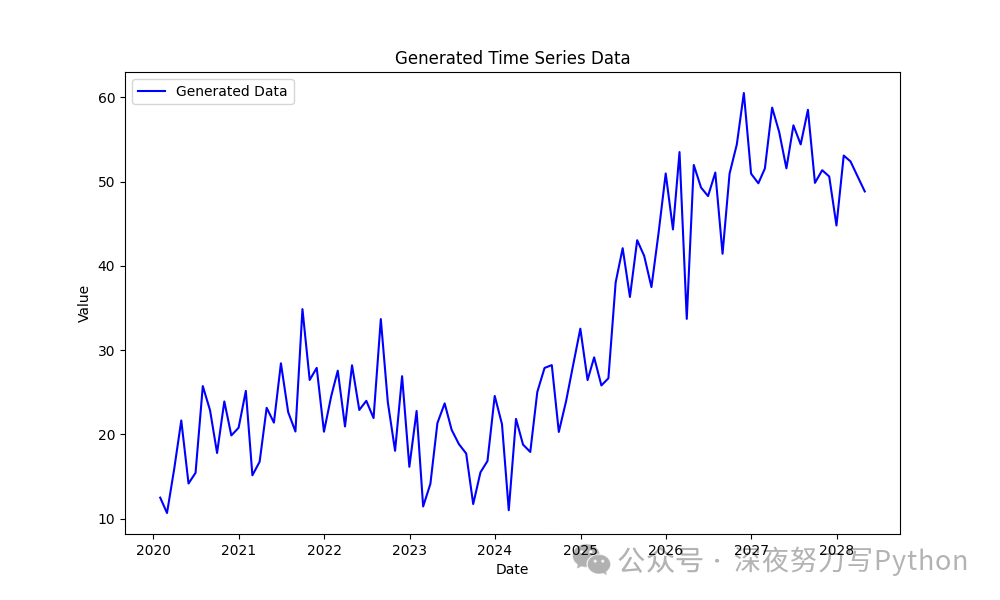
ARIMA 模型
ARIMA 适用于无季节性的时间序列数据。我们将对数据进行建模,并进行预测。
from statsmodels.tsa.arima.model import ARIMA
# 拟合 ARIMA 模型
arima_model = ARIMA(df['Value'], order=(5, 1, 0))
arima_result = arima_model.fit()
# 预测
df['ARIMA_Prediction'] = arima_result.predict(start=1, end=len(df), dynamic=False)
# 可视化 ARIMA 预测结果
plt.figure(figsize=(10, 6))
plt.plot(df.index, df['Value'], label='Actual', color='blue')
plt.plot(df.index, df['ARIMA_Prediction'], label='ARIMA Prediction', color='red')
plt.title('ARIMA Model Prediction')
plt.xlabel('Date')
plt.ylabel('Value')
plt.legend()
plt.show()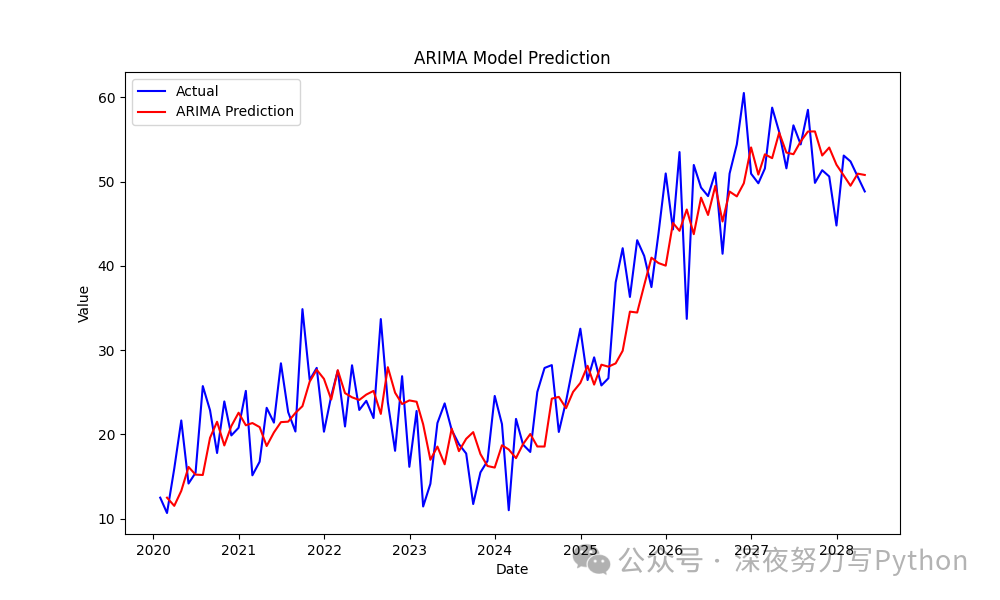
SARIMA 模型
SARIMA 是 ARIMA 的扩展,适用于带有季节性的时间序列数据。
from statsmodels.tsa.statespace.sarimax import SARIMAX
# 拟合 SARIMA 模型
sarima_model = SARIMAX(df['Value'], order=(1, 1, 1), seasonal_order=(1, 1, 1, 12))
sarima_result = sarima_model.fit()
# 预测
df['SARIMA_Prediction'] = sarima_result.predict(start=1, end=len(df), dynamic=False)
# 可视化 SARIMA 预测结果
plt.figure(figsize=(10, 6))
plt.plot(df.index, df['Value'], label='Actual', color='blue')
plt.plot(df.index, df['SARIMA_Prediction'], label='SARIMA Prediction', color='green')
plt.title('SARIMA Model Prediction')
plt.xlabel('Date')
plt.ylabel('Value')
plt.legend()
plt.show()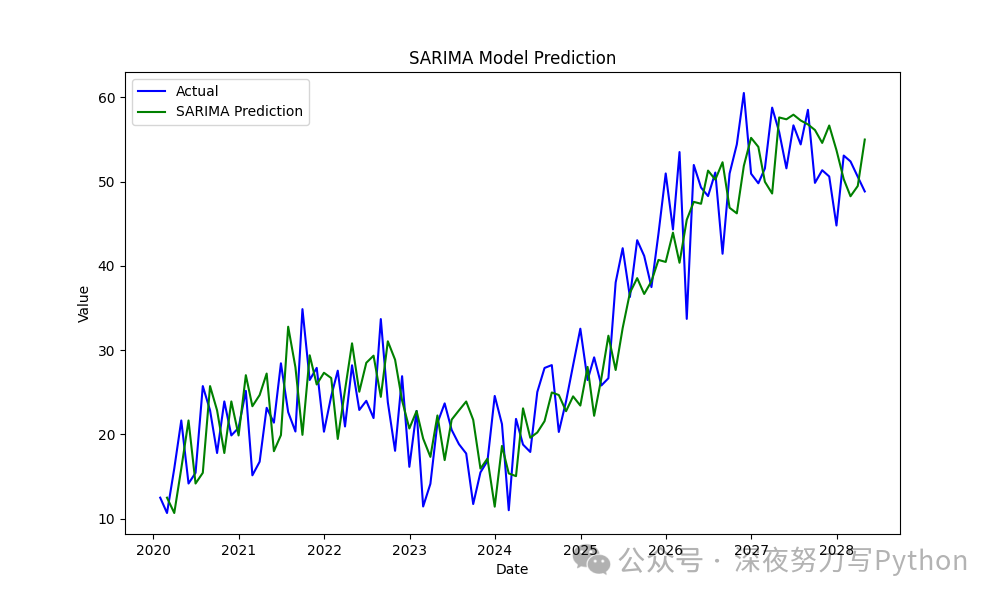
指数平滑法 (ETS)
ETS 模型适用于具有趋势和季节性的时间序列数据。
from statsmodels.tsa.holtwinters import ExponentialSmoothing
# 拟合 ETS 模型
ets_model = ExponentialSmoothing(df['Value'], trend='add', seasonal='add', seasonal_periods=12)
ets_result = ets_model.fit()
# 预测
df['ETS_Prediction'] = ets_result.predict(start=1, end=len(df))
# 可视化 ETS 预测结果
plt.figure(figsize=(10, 6))
plt.plot(df.index, df['Value'], label='Actual', color='blue')
plt.plot(df.index, df['ETS_Prediction'], label='ETS Prediction', color='purple')
plt.title('ETS Model Prediction')
plt.xlabel('Date')
plt.ylabel('Value')
plt.legend()
plt.show()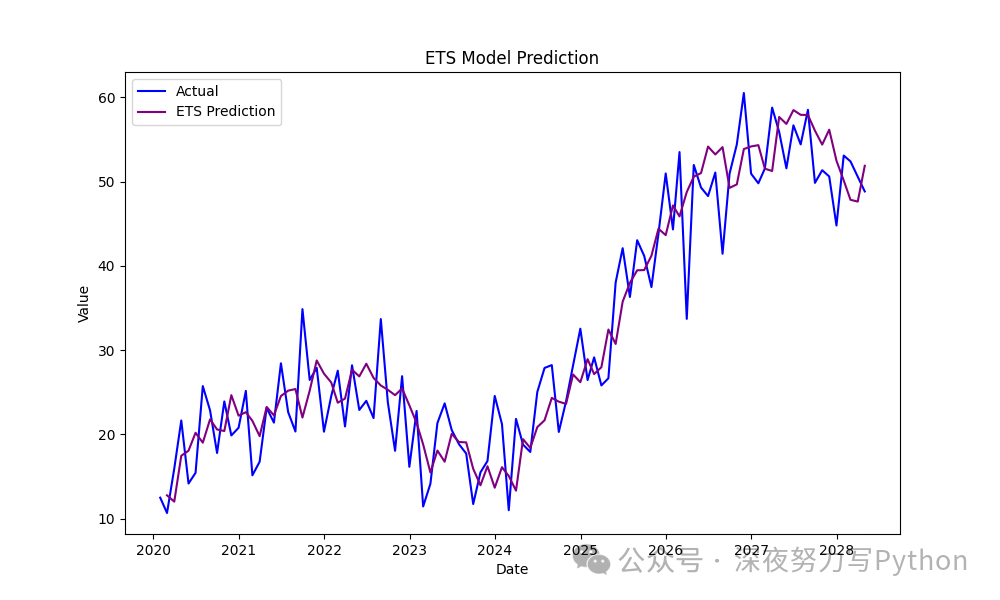
Prophet 模型
Prophet 适用于具有复杂趋势和季节性的时间序列数据,并且在处理缺失值和异常值时表现良好。
from prophet import Prophet
# Prophet 需要特定的数据格式
df_prophet = df.reset_index().rename(columns={'Date': 'ds', 'Value': 'y'})
# 拟合 Prophet 模型
prophet_model = Prophet(yearly_seasonality=True, weekly_seasonality=False, daily_seasonality=False)
prophet_model.fit(df_prophet)
# 预测
future = prophet_model.make_future_dataframe(periods=0)
forecast = prophet_model.predict(future)
# Prophet 结果处理
df['Prophet_Prediction'] = forecast['yhat'].values
# 可视化 Prophet 预测结果
plt.figure(figsize=(10, 6))
plt.plot(df.index, df['Value'], label='Actual', color='blue')
plt.plot(df.index, df['Prophet_Prediction'], label='Prophet Prediction', color='orange')
plt.title('Prophet Model Prediction')
plt.xlabel('Date')
plt.ylabel('Value')
plt.legend()
plt.show()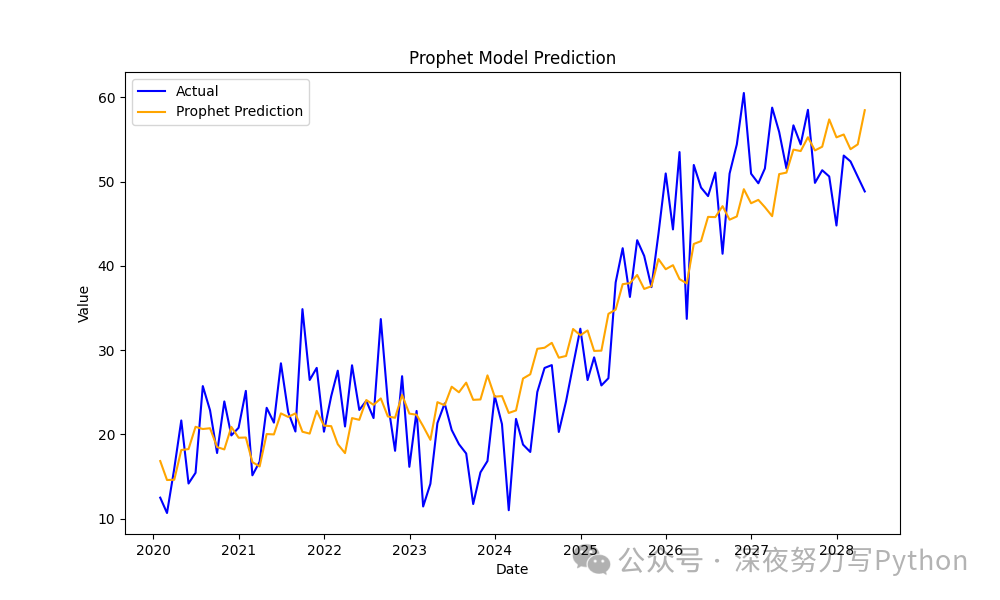
综合对比分析
将所有模型的预测结果绘制在一起进行比较。
plt.figure(figsize=(14, 8))
plt.plot(df.index, df['Value'], label='Actual', color='black', linewidth=2)
plt.plot(df.index, df['ARIMA_Prediction'], label='ARIMA Prediction', color='red')
plt.plot(df.index, df['SARIMA_Prediction'], label='SARIMA Prediction', color='green')
plt.plot(df.index, df['ETS_Prediction'], label='ETS Prediction', color='purple')
plt.plot(df.index, df['Prophet_Prediction'], label='Prophet Prediction', color='orange')
plt.title('Comparison of Different Time Series Models')
plt.xlabel('Date')
plt.ylabel('Value')
plt.legend()
plt.show()
不同形式的数据分析绘图
「残差分析图」
我们可以绘制每个模型的残差图,以观察预测误差的分布。
plt.figure(figsize=(14, 8))
plt.subplot(2, 2, 1)
plt.plot(df.index, df['Value'] - df['ARIMA_Prediction'], color='red')
plt.title('ARIMA Residuals')
plt.subplot(2, 2, 2)
plt.plot(df.index, df['Value'] - df['SARIMA_Prediction'], color='green')
plt.title('SARIMA Residuals')
plt.subplot(2, 2, 3)
plt.plot(df.index, df['Value'] - df['ETS_Prediction'], color='purple')
plt.title('ETS Residuals')
plt.subplot(2, 2, 4)
plt.plot(df.index, df['Value'] - df['Prophet_Prediction'], color='orange')
plt.title('Prophet Residuals')
plt.tight_layout()
plt.show()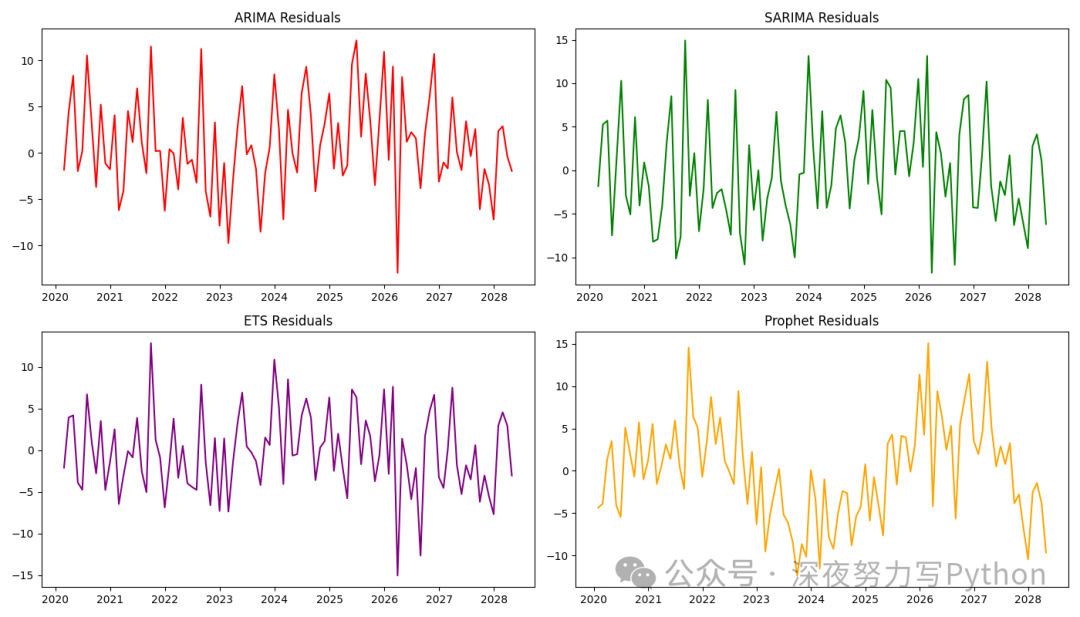
「预测误差的分布直方图」
绘制每个模型的预测误差的分布直方图,了解误差的分布情况。
plt.figure(figsize=(14, 8))
plt.subplot(2, 2, 1)
plt.hist(df['Value'] - df['ARIMA_Prediction'], bins=20, color='red', alpha=0.7)
plt.title('ARIMA Prediction Error Distribution')
plt.subplot(2, 2, 2)
plt.hist(df['Value'] - df['SARIMA_Prediction'], bins=20, color='green', alpha=0.7)
plt.title('SARIMA Prediction Error Distribution')
plt.subplot(2, 2, 3)
plt.hist(df['Value'] - df['ETS_Prediction'], bins=20, color='purple', alpha=0.7)
plt.title('ETS Prediction Error Distribution')
plt.subplot(2, 2, 4)
plt.hist(df['Value'] - df['Prophet_Prediction'], bins=20, color='orange', alpha=0.7)
plt.title('Prophet Prediction Error Distribution')
plt.tight_layout()
plt.show()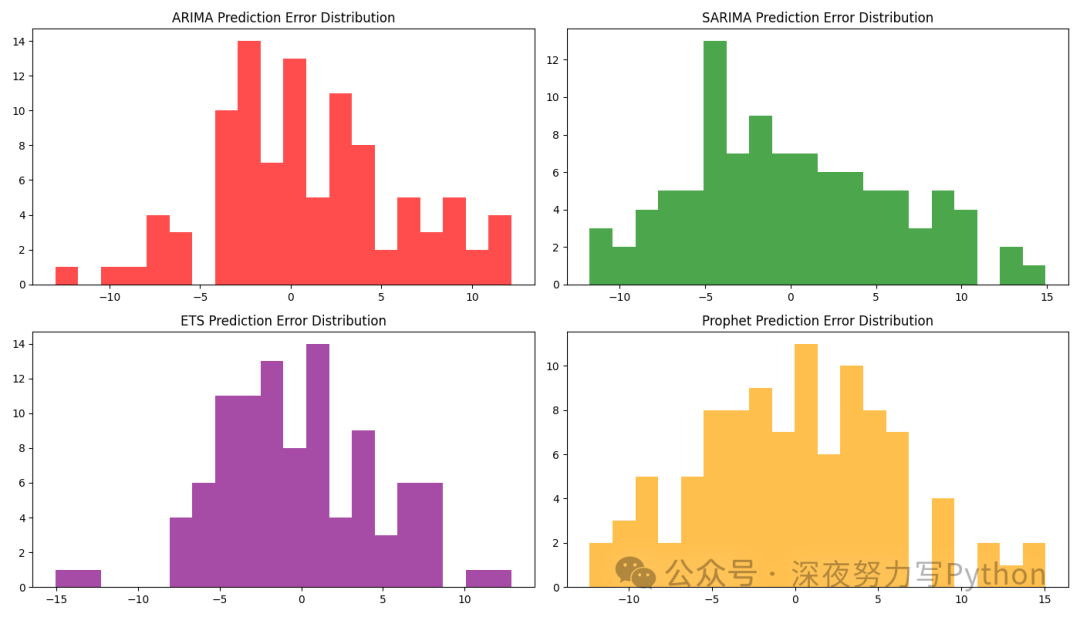
「模型预测与实际值的相对误差」
绘制每个模型预测值与实际值的相对误差百分比,以更直观地比较模型的预测准确性。
plt.figure(figsize=(14, 8))
plt.subplot(2, 2, 1)
plt.plot(df.index, (df['Value'] - df['ARIMA_Prediction']) / df['Value'] * 100, color='red')
plt.title('ARIMA Relative Error (%)')
plt.subplot(2, 2, 2)
plt.plot(df.index, (df['Value'] - df['SARIMA_Prediction']) / df['Value'] * 100, color='green')
plt.title('SARIMA Relative Error (%)')
plt.subplot(2, 2,
3)
plt.plot(df.index, (df['Value'] - df['ETS_Prediction']) / df['Value'] * 100, color='purple')
plt.title('ETS Relative Error (%)')
plt.subplot(2, 2, 4)
plt.plot(df.index, (df['Value'] - df['Prophet_Prediction']) / df['Value'] * 100, color='orange')
plt.title('Prophet Relative Error (%)')
plt.tight_layout()
plt.show()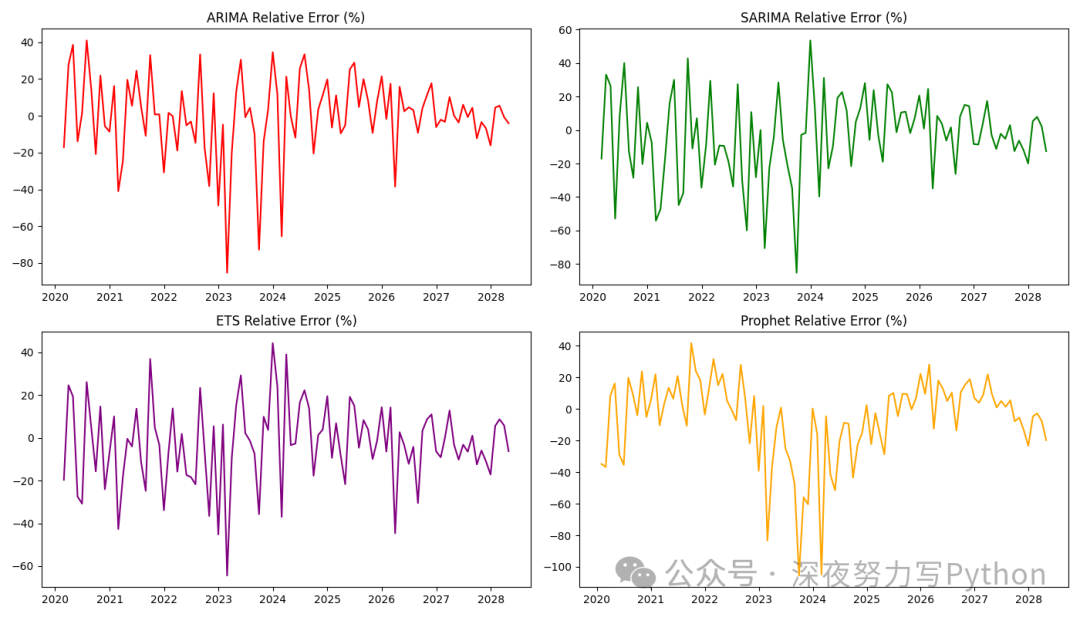
适用性和性能比较
ARIMA: 适用于无季节性或季节性非常微弱的时间序列。数据中存在明显季节性时效果较差。
SARIMA: 在数据具有季节性模式时表现良好,适合捕捉季节性和非季节性成分。
ETS (指数平滑法): 适用于具有趋势和季节性的时间序列,在处理复杂的趋势和季节性变化时表现良好。
Prophet: 适用于具有复杂趋势和多种季节性的时间序列,处理缺失值和突变时表现优异。
调参细节
ARIMA: 通过调整
p、d、q参数来平衡模型的复杂度和预测性能。通常使用 AIC 或 BIC 选择最优参数。SARIMA: 需要调整季节性参数
P、D、Q和季节周期m。与 ARIMA 相似,可以通过网格搜索或自动化工具来选择最优参数。ETS: 主要调节趋势 (
additive/multiplicative) 和季节性模型类型。通过调节seasonal_periods参数匹配数据的周期性。Prophet: 通过调整
changepoint_prior_scale来控制趋势的灵活性。可以根据需要开启或关闭年、月、周等周期性成分。
最后
在不同的时间序列预测任务中,根据数据的特性选择合适的模型至关重要。通过这四种算法的对比,我们可以更清晰地理解各自的优缺点,并根据数据特性和任务需求进行选择和调参,从而实现更好的预测效果。
大家有问题可以直接在评论区留言即可~

往期精彩回顾
适合初学者入门人工智能的路线及资料下载(图文+视频)机器学习入门系列下载机器学习及深度学习笔记等资料打印《统计学习方法》的代码复现专辑交流群
欢迎加入机器学习爱好者微信群一起和同行交流,目前有机器学习交流群、博士群、博士申报交流、CV、NLP等微信群,请扫描下面的微信号加群,备注:”昵称-学校/公司-研究方向“,例如:”张小明-浙大-CV“。请按照格式备注,否则不予通过。添加成功后会根据研究方向邀请进入相关微信群。请勿在群内发送广告,否则会请出群,谢谢理解~(也可以加入机器学习交流qq群772479961)
























 1072
1072

 被折叠的 条评论
为什么被折叠?
被折叠的 条评论
为什么被折叠?








